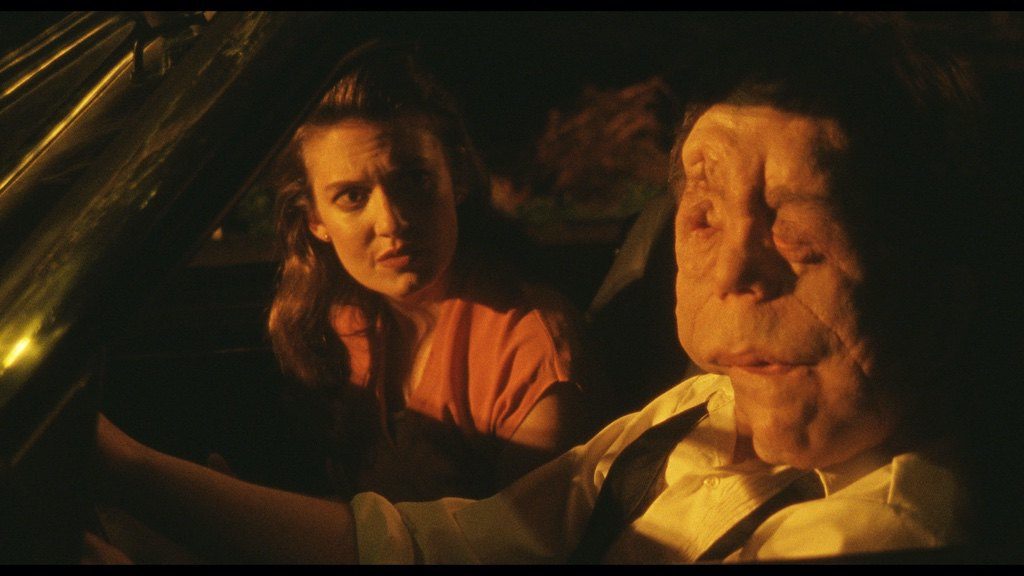Chained For Life is a film about the making of a film with other films nestled inside — one after another, huddled up like egg yolks in a well of flour — with director Aaron Schimberg gradually drawing the lot of them together to create an overarching film about community, perspective, and representation. Chained For Life encompasses a number of big ideas into a relatively small film production, which is shooting in an abandoned wing of a hospital by a German director (played by Charlie Korsmo) embarking on his first American production.
Based on his childhood growing up in the circus, Herr Director appears to be creating a type of fanfiction in retrospect with a narrative that sees a German doctor reversing the various ailments and disfigurements that a group of sideshow performers live with, which include (among others) conjoined twins; a burn victim a giant; a bearded lady; and the co-star, a man with facial abnormalities named Rosenthal (played by Adam Pearson).

These individuals account for the secondary casting while the film’s crew and its leads, Mabel and Max (played by Jess Weixler and Stephen Plunkett), make up the principal group. A sort of nervousness is developed between the two camps as they have been filming for some time while the secondary group is paraded through the established working relationships; furthering this separation is an ill-conceived decision to section them off between a nearby hotel and the abandoned hospital (guarding the equipment) during their off hours.
Through the filming, the downtime, the rehearsing and the after-hours moments, Schimberg plays with notions of perspective and representation. It is a meta playground wherein he is able to drill down deeper, retreat back or simply shift in little ways back and forth, which leads to a perpetual guessing game as to the current reality or non-reality. Even more disorienting is the fact that the film never hesitates in switching between points-of-view at the drop of a dime.
Herr Director is engaged in a self-serving artistic endeavor of imposed wish fulfillment, a fantasy world where he gets to write from the perspective of the malformed and handicapped without even thinking once if any of it makes sense or is a true representation. Mabel tries to justify portraying a blind woman who is surprised that other people are three dimensional with rich lives themselves while the rest of the cast and crew seem to treat the sideshow cast as novelties.

Much of it veers closely toward exploitation (as is the point), but the inclusion of the secondary cast’s viewpoints is what offsets any potential grazing of that label. Because they are in charge of the equipment within the confines of an abandoned hospital, with copious amounts of free time at their disposal, the lot of them take it upon themselves to create their own stories by creating their own short films.
They are unwittingly given the freedom to commandeer their lived experiences and images, in turn not creating sentimental claptraps desperate for sympathy but more so relationship dramas and unhurried scenes of dialogue. With Brutto (a great Sammy Mena, more Sammy Mena please) at the helm, everyone gets a chance to tell the types of stories they would like to tell, to play the roles that they would like to play yet are rarely afforded.
It all quickly becomes apparent that their dreams are pretty straightforward and easily achievable, especially, Rosenthal’s. A simple dream of working as a waiter —nothing more, nothing less. Just a waiter wanting to make your tuna melt dreams come true.

Schimberg has a knack for creating genuine, lived-in worlds that feel so much larger than his budget should allow, thanks in large part to his and his team’s ability to find and utilize these abandoned structures (similar to how an abandoned factory was used in his feature-length debut, Go Down Death). It is remarkable what his production team is able to do with these empty spaces, turning them into sprawling worlds full of imagination where anything could conceivably happen.
That is the main point of enjoyment that Schimberg and his collaborators bring out — their sense of imagination along with their ability to manifest these visions that seem at odds with their budget. But, somehow, they are able to do it. DIY movie magic, I suppose.
Performances across the board are a joy to watch, as even the smallest of roles —such as the aforementioned Mena, Lucy Kaminsky and Joanna Arnow — get a chance to leave their mark, in one way or another. It is the film’s two leads, Weixler and Pearson, who really make the most of their roles, benefitting from the fact that each gets to play a wide range in variation of their respective characters, acting across genres — essentially acting in a number of films but all in the same film. Matryoshka-doll roles in a Matryoshka-doll film. Both possess and exhibit a nimbleness in this task, shifting and adjusting their emotional starting points numerous times throughout.
Collaboration is key, and with a film such as this — one with a low budget, an expansive ensemble cast and a screenplay that sees nearly everyone’s character evolving and changing in some way — it’s the only way success can be had. This is the second time (after Go Down Death) that Schimberg has pulled it off, with a sense a genuine atmosphere of community on the screen. Not only is there an openness to various viewpoints but a trust in those particular viewpoints and the experience behind them.







